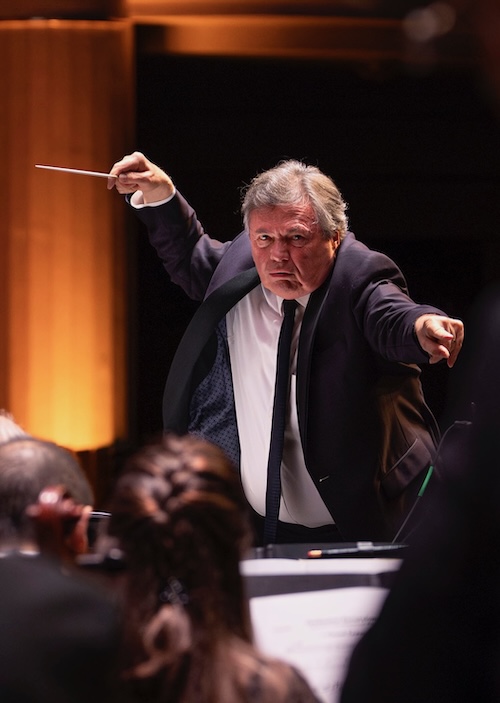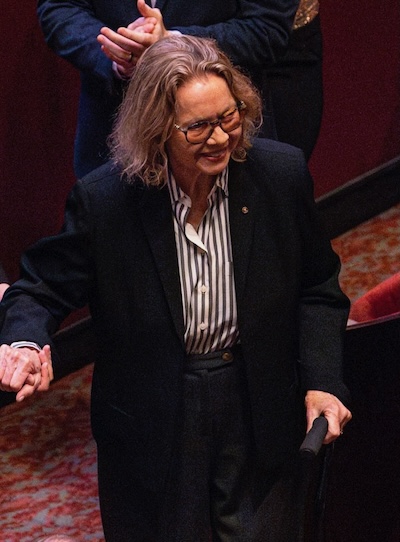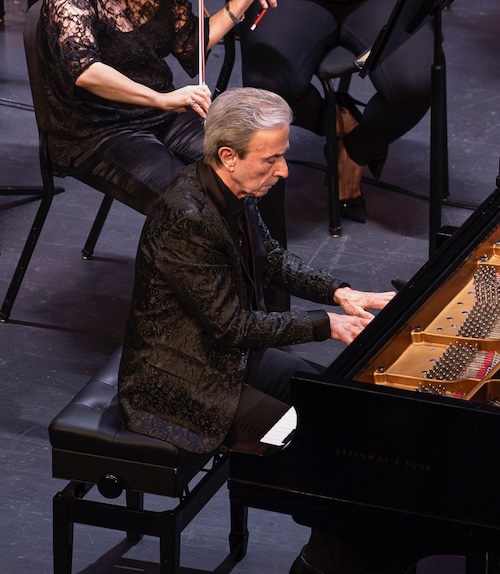Colorful Zwilich premiere highlights Palm Beach Symphony’s romantic program

Gerard Schwarz conducted the Palm Beach Symphony Monday night at the Kravis Center in West Palm Beach. Photo: IndieHouse Films
The distinguished American composer Ellen Taaffe Zwilich has never been called lazy.
The Miami-born composer and longtime seasonal Pompano Beach resident, has produced, so far, five symphonies, 27 concertos or similar compositions and dozens of other works. At 84, she is still composing, with her latest work receiving its world premiere Monday at the Kravis Center by the Palm Beach Symphony.
Orchestral Excursions (Inspired by Gilbert Maurer’s Art Work) was commissioned by Bonnie McElveen-Hunter, former U.S. ambassador to Finland, in honor of Maurer, a former executive of the Hearst media company and a watercolor painter. The result is a series of mini-tone poems that were accessible, melodic, brightly orchestrated and atmospheric.
As conductor Gerard Schwarz led the orchestra, images of the artist’s paintings appeared on a screen above the stage. There was a painting of the modernistic Hearst tower in New York, constructed around an older building. Ominous low strings opened the movement, leading to an ascent to clanging, sonorous brass playing—all of which seemed to capture the primal, elemental force of big-city buildings.
A painting of the Cathedral of Santiago de Compostela inspired a rhythmic march rhythm and a viola melody. The San Marco Cathedral in Venice produced organ-like music in the brass, marred Monday by some sloppy entrances, and formal, choir-like processions of harmonies in strings.
Another Venetian painting led to an homage to Vivaldi, with strings launching into an excerpt of “Autumn” from The Four Seasons. The final painting, “Palm Beach,” had moments of misty uncertainty that led to an unambiguously affirmative ending. Zwilich, who was in the audience, was invited by Schwarz to walk toward the stage and face the audience to share in the standing ovation.

Composer Ellen Taaffe Zwilich acknowledges the audience applause following the world premiere of her Orchestral Excursions Monday night. Photo: IndieHouse Films
The pianist Santiago Rodriguez is a well-known figure in South Florida, where he chairs the keyboard department at the University of Miami’s Frost School of Music in addition to pursuing his concert career. Filling in for the previously announced Vladimir Feltsman, he performed the Grieg Piano Concerto.
Unlike some pianists, he did not treat the concerto as the occasion for violent virtuosity. Although he could pound away in double octaves when required, he integrated his performance into that of the orchestra and brought a range of tone colors to the keyboard. He could play with sweeping virtuosity, as he did in the cadenza. And he could bring a feathery, non-percussive touch to the instrument in the first movement’s melodies.
The best part of the performance by both pianist and orchestra came in the Adagio, with Rodriguez’s sensitive phrasing and tone coloring in the delicate melody, with its froth of ornamentation. He brought crisp authority to the last movement theme, joining with Schwarz and the orchestra to play with sizzling excitement to the close.
In response to a standing ovation, Rodriguez played his own transcription of the slow movement of Schumann’s Violin Concerto, a simple melody that couldn’t have contrasted more with the fireworks of the Grieg. He followed that with a vigorous if not note-perfect performance of Rachmaninoff’s Prelude in G Minor.

Santiago Rodriguez played Grieg’s Piano Concerto with the Palm Beach Symphony Monday night. Photo: IndieHouse Films.
Few works show off an orchestra to better effect than Rimsky-Korsakov’s giant tone poem Scheherazade, inspired by the story of One Thousand and One Nights.
Under Schwarz’s leadership, the musicians made the most of this richly colored score. The orchestra surged and rolled in the turbulent music of the first section that evokes the sea. Aggressive brass playing brought elemental force to the jagged rhythms in the “Story of the Kalendar Prince.” The orchestra glowed in the erotic melody of the romantic third movement.
The work abounds in solos, with bassoon, oboe, clarinet and other instruments taking turns. Schwarz allowed each orchestral soloist the room to play in a free manner, resulting in passages that were full of individual personality.
The work contains one of the most demanding series of violin solos in the repertory, as the violin personifies Scheherazade, the wife of the Sultan who beguiles him with stories. Concertmaster Evija Ozolins brought the music to life with a pure tone and a free style of playing, delivering all the virtuosity required in music that involves high passages, chords and bouncing the bow across the strings.
The Palm Beach Symphony’s season continues 7 p.m. March 6 with the world premiere of a work by Aaron Kernis, Tchaikovsky’s Symphony No. 4 and Mozart’s Piano Concerto No. 25 with soloist Emanuel Ax. palmbeachsymphony.org
Posted in Performances
Leave a Comment
Tue Feb 6, 2024
at 1:19 pm
No Comments
